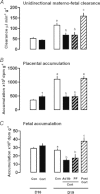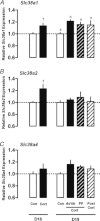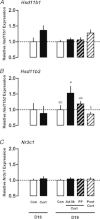Maternal corticosterone regulates nutrient allocation to fetal growth in mice
- PMID: 22930269
- PMCID: PMC3515836
- DOI: 10.1113/jphysiol.2012.239426
Maternal corticosterone regulates nutrient allocation to fetal growth in mice
Abstract
Stresses during pregnancy that increase maternal glucocorticoids reduce birth weight in several species. However, the role of natural glucocorticoids in the mother in fetal acquisition of nutrients for growth remains unknown. This study aimed to determine whether fetal growth was reduced as a consequence of altered amino acid supply when mice were given corticosterone in their drinking water for 5 day periods in mid to late pregnancy (day, D, 11-16 or D14-19). Compared to controls drinking tap water, fetal weight was always reduced by corticosterone. At D16, corticosterone had no effect on materno-fetal transfer of [(14)C]methylaminoisobutyric acid (MeAIB), although placental MeAIB accumulation and expression of the Slc38a1 and Slc38a2 transporters were increased. However, at D19, 3 days after treatment ended, materno-fetal transfer of MeAIB was increased by 37% (P < 0.04). During treatment at D19, placental accumulation and materno-fetal transfer of MeAIB were reduced by 40% (P < 0.01), although expression of Slc38a1 was again elevated. Permanent reductions in placental vascularity occurred during the earlier but not the later period of treatment. Placental Hsd11b2 expression, which regulates feto-placental glucocorticoid bioavailability, was also affected by treatment at D19 only. Maternal corticosterone concentrations inversely correlated with materno-fetal MeAIB clearance and fetal weight at D19 but not D16. On D19, weight gain of the maternal carcass was normal during corticosterone treatment but reduced in those mice treated from D11 to D16, in which corticosterone levels were lowest. Maternal corticosterone is, therefore, a physiological regulator of the amino acid supply for fetal growth via actions on placental phenotype.
Figures




References
-
- Asiaei M, Solati J, Salari AA. Prenatal exposure to LPS leads to long-lasting physiological consequences in male offspring. Dev Psychobiol. 2011;53:828–838. - PubMed
-
- Audette MC, Challis JR, Jones RL, Sibley CP, Matthews SG. Antenatal dexamethasone treatment in midgestation reduces system A-mediated transport in the late-gestation murine placenta. Endocrinology. 2011;152:3561–3570. - PubMed
-
- Audette MC, Greenwood SL, Sibley CP, Jones CJP, Challis JRG, Matthews SG, Jones RL. Dexamethasone stimulates placental system A transport and trophoblast differentiation in term villous explants. Placenta. 2010;31:97–105. - PubMed
Publication types
MeSH terms
Substances
LinkOut - more resources
Full Text Sources
Medical
Miscellaneous

